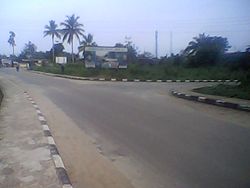Ikot Abasi
|
Ikot Abasi Ikot Abasi, Nigeria |
|
|---|---|
| LGA | |
 |
|
| Nickname(s): Alu City | |
| Location in Nigeria | |
| Coordinates: 4°38′0″N 7°39′0″E / 4.63333°N 7.65000°E | |
| Country |
|
| State | Akwa Ibom State |
| Capital | Uyo City |
| Headquarters | Ikot Abasi |
| Government | |
| • Type | Traditional |
| • Edidem | HRH Udo Joe Ntuk Obom XII |
| Population (2006) | |
| • Total | 132,023 |
| 2006 National Census | |
| Time zone | WAT (UTC+1) |
| Climate | Am |
| Website | http://www.aksgonline.com/lga.aspx?qrID=ikotabasi |
Ikot Abasi is located in the south west corner of Akwa Ibom State, Nigeria. It is bounded by Oruk Anam Local Government Area in the north, Mkpat Enin and Eastern Obolo Local Government Areas in the east and the Atlantic Ocean in the south. The Imo River forms the natural boundary in the west separating it from Rivers State.
The people of Ikot Abasi are made up of the Ibibio ethnic group with diverse cultural heritage and tradition. They speak the Ibibio language.
Ikot Abasi is made up of five clans namely: Ikpa Edemaya Clan, Ikpa Ibekwe Clan, Ikpa Nnung Assang Clan, Ukpum Ette Clan and Ukpum Okon Clan.
Villages in Ikpa Ibekwe are: 1. Ata Udo-Usung; 2. Ikot Abasi; 3. Ikot Aba; 4. Ikot Akpan-Ata; 5. Ikot Essien; 6. Ikot Etetuk; 7. Ikot Obong; 8. Ikot Ukpo-Inua; 9. Ikpetim; and 10. Uta Ewa
Because of its location at the break in the mangrove swamp and rain forest of the eastern Niger River delta, it was a collecting point for slaves in the 19th century. in 1870, Jubo Juboha came to Ikot Abasi and founded the kingdom of Opobo. He was a former Igobo (Ibo) slave.
Ikot Abasi, a community in then Calabar Province, for good reasons. Although Ikot Abasi, formerly part of the famed Opobo Kingdom, was already on the world map before 1929, the women’s uprising against Nigeria’s colonial rulers in 1929 was to provide a further push into prominence for this town, then already popular as the site of a famous boat yard, seat of a British consulate and part of the late King Jaja’s area.
Three-quarters of a century ago, Ikot Abasi was one of a number of towns in both Calabar and Owerri provinces, whose women bravely took exception to what they considered exploitative excesses of the British rulers of the then non-independent Nigeria.
In 1995, the year of that famed Beijing conference, the National Gallery of Modern Art, Lagos (NGA) put out a very important book, The women’s revolt of 1929. The book, which features contributions from notable academics like Prof. Monday E. Noah, Prof. Obaro Ikime and Chief N.U. Akpan, among others, reminds that one of the women killed by the colonial forces during the 1929 protest was the mother of a boy, Egbert. That lad would later grow into a famous jurist and administrator (Justice Egbert Udo Udoma). Such was the impact of the reforms that trailed the woman’s protest that the March 8, 1933 issue of the Daily Times described the changes as "the great charter of liberty for the people". But the prize did not come easy. Prof. M. E. Ekpo, another of the book’s contributors, revealed that in the Calabar Province alone, more than 53 people were killed beside over 50 others injured.
...
Wikipedia

